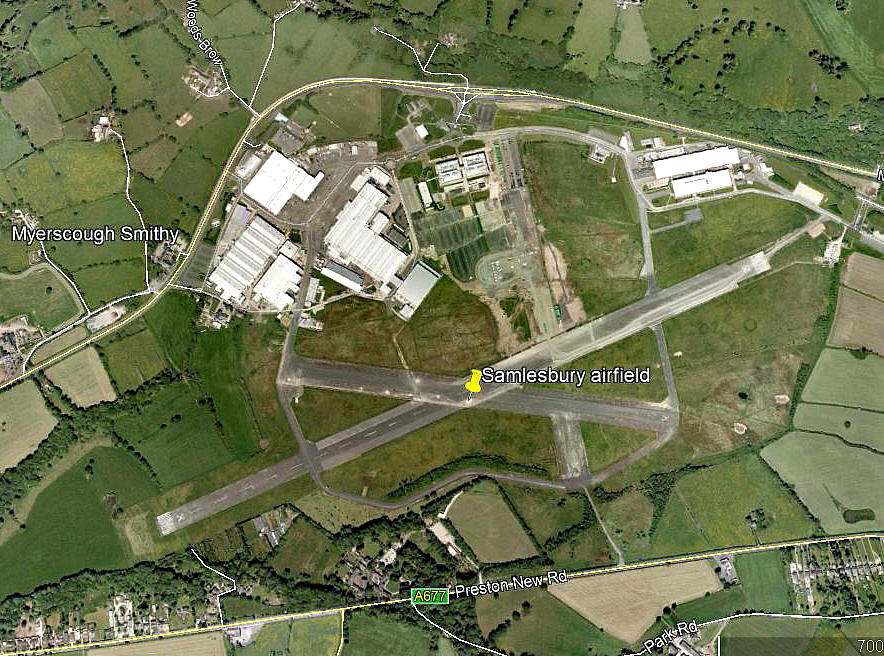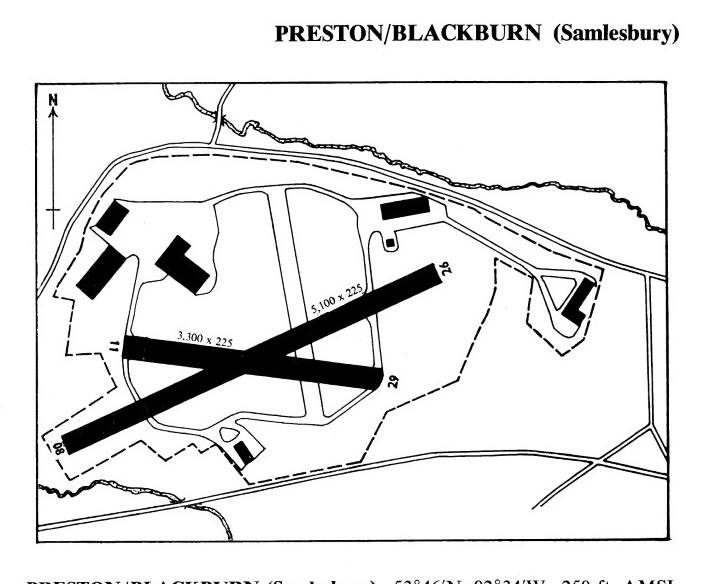Samlesbury
SAMLESBURY: Civil company/military aerodrome (also known as BLACKBURN)
Note: This picture (2009) was obtained from Google Earth ©
Operated by: During WW2 and beyond the English Electric Co.
1975: British Aircraft Corporation
1980s to 2000: British Aerospace
Manufacturing: WW2: The English Electric Co (Handley Page Hampden & Halifax production)
Post 1945: BAC, BAe, English Electric, Salmesbury Engineering/Lancashire Aircraft Company
Gliding: 1970s only? BAe 635 VGS (Volunteer Gliding School)
1960s to roughly the early 1970s?: Blackpool & Fylde Gliding Club
Note: This club started operating out of BLACKPOOL SQUIRES GATE, probably in the 1950s only? When the airport became busier they transferred to here and also WARTON and stayed until the early 70s. They then moved in 1976, to a permanent site near Chipping in the SW corner of the Forest of Bowland, changing its name to Bowland Forest Gliding Club. See seperate entry - BOWLAND FOREST.
Location: Between the A59 & A677 just E of where they diverge, 4nm E of Preston
Period of operation: 1937 (Some say 1939) to – 1980s?
Note: This map is kindly reproduced with permission from Pooleys Flight Equipment. Copyright Robert Pooley 2014
Runways: Originally grass but in early WW2 with one hard runway later extended in 1940
Aerial photographs I have seen clearly indicate that, (probably later in WW2?), two other hard runways were constructed.
1965: 08/26 1554x69 hard 11/29 1006x69 hard
The last info appears to be: 08/26 2422 hard
NOTES: It seems that SAMLESBURY was originally set up by Preston and Blackburn Councils to be their joint municipal aerodrome in 1937, but the MAP (Ministry of Aircraft Production) intervened at some point prior to WW2 and requisitioned the site.By 1941 it seems 770 Handley Page Hampdens had been built here by English Electric. Also, a total of 2145 Handley Page HP57 Halifaxes were built here starting in 1940. After 1945 it is claimed over 1,350 Vampires also were test flown here.
It needs to be remembered, especially regarding the entry below, that test flying of military types was not a concern of the military, until the aircraft was handed over.
WW2 MILITARY FLYING
Military flying here in WW2 seems to be confined to No.9 Group Communications Flight which, between 1940 and 1944 operated a rare mixture of aircraft including the rare Curtiss Cleveland which was a version of the USN Helldiver type. I’m assuming that No.9 Group Communications Flight were actually based here,?
But. even if they weren’t, their inventory of aircraft seems well worth mentioning: Comprising it seems the D.H.87B Hornet Moth W5774, (ex G-AEPV), D.H.85 Leopard Moth AV989, (ex G-ADAP), Hawker Hurricanes Mk.Is L1740, P2822 & R4231, Mk.IIb JS359 and Mk.X AG281. I was astonished to learn that front line fighters slightly beyond their ‘sell by date’ were often used as ‘Communication’ hacks in WW2.
Joining these ranks were the Miles Master Mk.1 N8052 and Mk.IIs P6818 and V3731, the Miles Mentor L4410 and the De Havilland Dominie I X7492. Swelling this already highly disparate bunch of aircraft were the Westland Lysander II N2001, Percival Vega Gull P1754, Miles Magister Is R1977 and R1982 and hardly surprising I suppose a batch of three D.H.82A Tiger Moths including a Mk.1 T6300 and two Mk.2s T5429 and DE310.
The Miles Martinet JN653 might seem an odd addition but three Spitfires were also involved it seems, the Mk.Vb BM533 and two Mk.IX, AB917 plus MJ679.
I will readily admit to being a bit ‘thick’ to say the least, but can anybody explain to me, given the almost world-wide theatre of war operations at this period in time - why these Hurricanes and Spitfies, let alone the Curtiss Cleveland, had been relegated to flying ‘communication’ duties? This said, I have read accounts stating we were supposed to be fighting a major war at this time in our history, (weren’t we?), so I’m trying to imagine the effort, time and resources required to keep such a fleet of aircraft airworthy?
THE CANBERRA ERA
It appears that, apart from the prototype all subsequent versions of the English Electric Canberra were built and test flown here, a type which proved to be an astonishing success with a total of 1,376 being built between 1949 and 1959, 925 of which were built in Britain by English Electric (631), Short Bros & Harland (144), A V Roe (75) and Handley Page (75). In Australia 48 were built and in the USA 403 Martin B-57. In all twenty three countries operated the Canberra and some remained in service into the early years of the 21st century, the RAF retiring the type in 2006. The Canberra also set five world records including three altitude records. It is claimed the Canberra could fly higher than any other jet during the 1950s
One small point of interest is that early production Lightnings were flown out of here but had to go to WARTON to land, the runway at SAMLESBURY being too short. This said, flight testing was planned to take place at WARTON anyway.
ANOTHER ASPECT
But I would like to add one point. Even after WW2 British designers of military aircraft invariably gave little if any thought as how the aircraft could be best operated by the crews flying the aircraft. (This applied to civil types too of course). Cockpits were usually an utter disgrace ergonomically. Indeed, some were difficult for the pilot to even see out of. The very long lived Canberra for example, and the de Havilland Sea Vixen, a type whose service history is an utter scandal. Still to be exposed.
I have heard it said by pilots and crew that they looked upon cockpit as if the designer had folded up bits of paper with the instrument names on, put them in their mouth and chewed on them, sat in the mock-up cockpit and spat them out. If they stuck that’s where they were sited, if some fell on the floor they’d put them there too. The exercise was repeated for all the knobs, levers, handles and buttons etc.
From what I’ve seen in museums this opinion is only slightly exaggerated. I can now imagine, having heard a few accounts by those involved, that maintaining these aircraft were getting very irate saying something like, “That’s nothing, you should see how these idiots expected us to maintain and repair the bloody things!”
Having flown many types of light aircraft, I have come to conclusion that the principle role of aircraft designers is to make a machine that is really quite safe to operate, as dangerous as possible. And, I am pleased to say, this notion has been affirmed to be correct time and time again. Just look at the conclusions of thousands of accident reports over several decades.
AN INTERESTING DEBATE
Even today major design faults have been found in, for example, both Airbus and Boeing aircraft. Sometimes giving the impression that the designers have little idea about so many functions, including how aircraft should be designed to fly! And yet, these often fatal flaws still manage to escape through the highly detailed and very thorough certification process.
I suppose at least one reason is – it is nigh on impossible for a rational, intelligent, knowledgeable and highly experienced person to think about looking for, checking for and testing for - something incorporated into the design by an utter wanker involved. Oddly, when a catastrophic accident occurs, due to a major design failure, those people responsible are never brought to account. Why not?
These are not just minor details either, in some cases relating to major airframe components such as the tail and rudder assembly being hugely defective, or the computerised flight management system for example containing serious errors.
THE EP.9 SAGA
In 1958 the Edgar Percival Company building the EP.9 crop-sprayer type at STAPLEFORD TAWNEY in ESSEX encountered severe financial difficulties and was taken over by Samlesbury Engineering later to become the Lancashire Aircraft Company. Here the E.P.9 was renamed the “Prospector” and after 43 were built production ceased.
Another claim to fame by Samlesbury Engineering was that they were the main constructors of Donald Campbell’s record breaking Bluebird.
In 1975 it seems that Canberra overhauls was the main activity and in 1976/7 it appears that just two notable GA types were based here. Firstly the GY-20 Minicab G-AWEP and secondly the BAC Petrel G-BACA registered to the BAC Military Aircraft Division, Apprentice Training Department. I reckon there’s a story still worth telling here for that latter type?
We'd love to hear from you, so please scroll down to leave a comment!
Leave a comment ...
Copyright (c) UK Airfield Guide

















